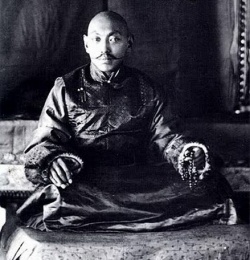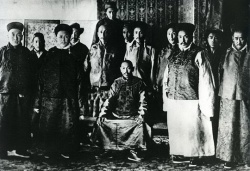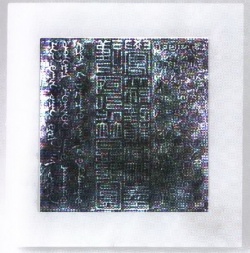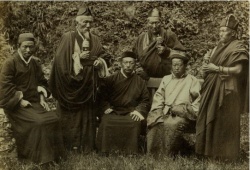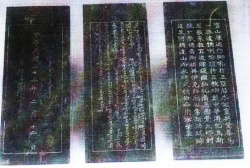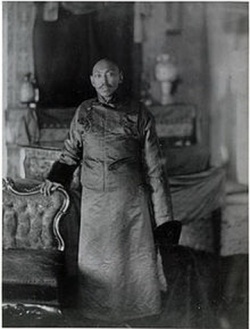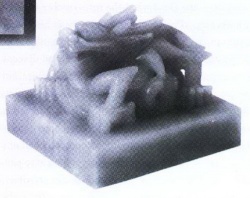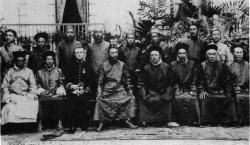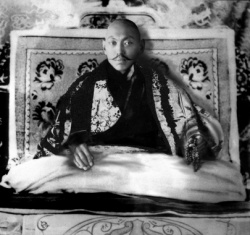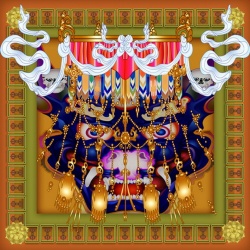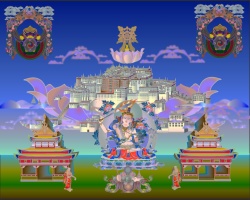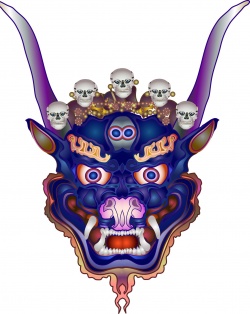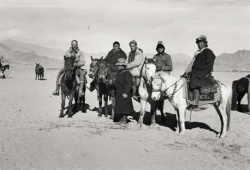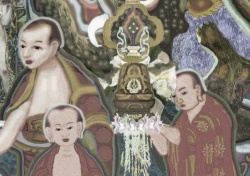On the Thirteenth Dalai Lama Ngawang Lozang Thubten Gyatso
The thirteenth Dalai Lama Ngawang Lozang Thubten Gyatso was a very spectacular and complex character on the political stage of Tibet in modern times. His experience of a lifetime of frustrations reflected the then tempestuous and changeable situation. Any evaluation of a Tibetan political and religious leader has always been a contentious
problem in academic circles, because it involves the explanation and exposition of relations between the Tibetan local government and the Central Government after the Revolution in 1911. For a long time I have had a keen interest in the "the Great Thirteenth," as he has been called. After a long period of study I have formed my viewpoint on this historical figure, and I present it here to solicit reader's opinions.
The source of the materials in this paper was mainly from my interviews with some aristocrats, officials and scholars in the 1950s, including Lhalu Tsewang Dorje, Chapel Tseten Phuntsok, Langdun Kunga Wangchuk, Thubten Kunphel, [[Pangda
Dorje]], and Shatra Paljor Dorje. Some materials came from official archives of the former Tibetan local government, which I read when I worked in Tibet. So, as I will not acknowledge individual sources of the materials of this paper I express acknowledgment to them all here.
The original name of the thirteenth Dalai Lama's is [[Lozang[Thubten Gyatso]] (blo-bzang rgya-mtsho). He was born in the village of Langdun in the district of Dagpo on the twenty-seventh day of June in 1876. He was confirmed the reincarnation of the twelfth Dalai Lama. A joint request was then made by the entire lay and clerical staff of the great monasteries, asking the
Emperor Guangxu through Qing's Grand Minister Resident of Tibet (Amban) for permission to omit the lot-drawing process. Their request was permitted.
The thirteenth Dalai Lama was born at a time when China was in an important transformation period of its history. The Opium War in 1840 marked the decline of China from an independent feudal society into a semi-colonial and semi-feudal society under the penetration and invasion of
Western powers. Located in the southwestern corner of China, Tibet also became the theater for the struggle between the then two strong imperialist countries-Britain and Tsarist Russia. Many of the unequal treaties signed by the Qing government with Britain involved trade, missionary activities, travel, and investigations in Tibet.
The British aggression into Tibet ran into conflict with Tsarist Russia's interests. Before the conclusion of the "Convention between Great Britain and Russia" in 1907, Tsarist Russia had attempted to take Tibet as a trophy of its influence over South Asia and thus Tibet became an important battlefield for Britain and Russia for
hegemony over Central Asia and the Southern sub-continent. As Tibet is close to India, the British incited the pro-British rulers of Nepal to launch an aggressive war against Tibet and force China to sign an unequal treaty that infringed the rights and privileges of Tibetans. Afterwards, all of Tibet's near neighbors and places strongly influenced by
Tibetan culture, from Ladakh in the west to Sikkim and Bhutan in the east, all fell under the control of Britain and Tibet lost the buffers that might block the invasion of foreign powers. Under such circumstances, it was a matter of
course for the British imperialists to wage a series of aggressive wars in 1888 and 1904. Tibet, like the hinterland of China, also suffered from serious foreign aggression.
At the same time, inside the Tibetan polity, the merging of religious and secular rule under the feudal serfdom made Tibetan social and economic development fall into stagnation for a long time. Moreover, under the regency, Tibetan clerical and
secular officials ganged up and formed cliques to pursue selfish interests. They jostled against each other for political power. Their internal rivalry never ceased. All this hindered the development of Tibetan society and polluted the Buddhist doctrine of doing well and benefiting others.
Influenced by these external and internal factors, the weaknesses and disadvantages of the closed and conservative ideology of Tibetan society were revealed. The feudal rulers could not find a way to overcome the crisis. They could only take a position of resistance and opposition to change and could do nothing significant in the face of external invasion. In respect of the relations between the
Tibetan local government and the Central government, starting from 1719 when the Dzungar troops were driven out of Tibet, the Qing court took a series of measures to strengthen its direct rule over Tibet. The establishment of the Amban system at a later time marked the peak of this rule. However, with the decline of the Qing court, it could no longer devote much attention to the
affairs of Tibet. The high-ranking officials sent to Tibet were no longer men of insight and with the breadth of vision but were muddleheaded and incompetent people, some of them were sent to Tibet as a punishment and an opportunity for them to redeem themselves by good service. That Tibetan affairs would deteriorate was unavoidable. The combination of the evil practices of the
Qing officialdom and the corruption of Ganden Photrang (dgav-ldan pho-brang) meant that Tibetan political circles permeated with outmoded conventions and bad customs. Even if some officials wanted to stop the decline, they could do nothing. Under such circumstances, Tibetan clerical and secular rulers began to use duplicitous tactics towards the Central government.
Therefore, we can say that the overall deterioration of the Tibetan political situation was inevitable. Around 1870 a rascal lama named Palden Dondrup (dpal-ldan don-grub) appeared in the Tibetan political arena and he became the Chikyap Khenpo (spyi-khyab mkhan-po), who monopolized political power in Tibet and held sway over the region for some time.
The reason for this phenomenon and a reasonable explanation for it could only be found in the corruption and evil practices of the Central government of the Qing court and Tibetan society. To obtain a complete and reasonable
explanation, we often need to make a cultural analysis of historical events. It seems to me that this is particularly true in the study of Tibetan history.
The process of searching for the re-embodiment of the Dalai Lama began with the third Dalai Lama. The records of the process of searching for the thirteenth Dalai Lama were highly detailed and the process was equally complex. All these precious Tibetan
archives have been preserved intact at Lhasa. After consulting a great amount of Tibetan materials collected at the Tibetan Archives, Kelsang Drolkar (skal-bzang sgrol-dkar), research fellow with the China Tibetology Research Center, wrote a
thesis entitled "How the thirteenth Dalai Lama Thubten Gyatso was selected," which gave a detailed account of the search for and the enthronement of the thirteenth Dalai Lama:1
A jade seal given to the 13th Dalai Lama by the Nationalist Government to confer posthumously the title of honor to the Dalai Lama
(1) After the twelfth Dalai Lama passed away, many Buddhist prayer meetings were held for the early coming of his re-embodiment.
(2) The infant candidate of the deceased Dalai Lama should be searched for in the direction in accordance with the direction of the body-inclination of the twelfth Dalai Lama.
(3) The Tibetan local government twice proclaimed the whole region regarding the search for the re-embodiment of the Dalai Lama.
(4) The Tibetan local government, seeking information on the direction in which the incarnate Dalai could be found, consulted the Panchen Lama for an oracle.
(5) The Tibetan local government three times consulted the Nechung (gnas-chung), the medium with the main protector of the Tibetan local government, for oracles on the direction in which the incarnate Dalai could be found and on the characteristics of the place.
(6) In the Potala, the Nechung Oracle replied that the re-embodiment has been born in a village east of Lhasa, that his parents, names are so-and-so, and that highly revered priests should be sent to look for him.
(7) The Gyu-to Khensur (rgyud-stod mkhan-zur) (retired Khenpo of the Upper Tantric college was sent by the Tibetan local government to examine the reflections in the Lhamoi Lhatso.
(8) Local officials reported that they had discovered a very wise baby boy. The local officials' information took the Gyu-to Khensur to the village of Langdun (glang-mdun) where he conducted a secret investigation.
(9) The Gyu-to Khensur paid his first visit to the baby boy.
(10) When he returned to Lhasa, the Khensur submitted a detailed report of his investigation to the authorities, and the regent and others expressed their satisfaction with the Langdun boy.
(11) The process of the search for the re-embodiment of the deceased Dalai was reported to the Qing court through the Grand Minister Resident of Tibet, Emperor Guangxu ordered a check on the report.
(12) The Gyu-to Khensur was sent to Langdun again to make an investigation of the baby boy. He placed in front of the boy some of the objects that the twelfth Dalai Lama had used. The Yellow Sect believes that the boy who picks up articles used by the deceased Dalai is his reincarnation.
(13) All other candidates from other places were denied.
(14) so that the baby boy might be exempted from the lot-drawing process, the Regent requested the Panchen Lama to intervene into the matter.
(15) The Regent asked the emperor for the permission to omit the lot-drawing process.
(16) High-ranking lay and clerical officials were sent in groups along the road to welcome the child candidate for the [[Dalai] Lama]].2
(17) The child candidate for the Dalai Lama listened to Emperor Guangxu's imperial edict about the permission to omit the lot-drawing process at Tsel Gungtang monastery.
As in the preceding case of the ninth Dalai Lama, the two Grand Ministers Resident of Tibet were requested to read out the imperial edict. In the Nyi-od Khang Hall the re-embodi-ment of the Dalai Lama sat facing the east, behind him were the Regent Kundeling (Kun-bde gling), sutra teachers, and high-ranking lay and clerical officials. The Grand Minister Resident
of Tibet read out Emperor Guangxu's imperial edict: "Lozang Thubten Gyatso, the son of Kunga Rinchen, may be proclaimed the reincarnation of the Dalai Lama without resorting to the drawing of lots from the gold urn." After
the announcement, the Dalai Lama offered a katag to the east to show his gratitude to the Emperor, and then he requested the Amban to present the katag to the Emperor for him. This ceremony was followed by a celebration ceremony.
(18) The reincarnation of the Dalai Lama moved his residence to the Rikya-Samtenling Monastery.
On the eighteenth day of the first month, the reincarnation of the Dalai Lama, accompanied by the regent, high-ranking incarnate lamas, and lay and clerical officials, proceeded from the Tsel Gungthang Monastery to the Rikya-Samtenling Monastery to the
north of the Lhasa River, where he awaited the enthronement ceremony. According to tradition, only after the re-embodiment attained at the age of four, could he undergo the enthronement ceremony. So, he lived there for more than one year before a date for his enthronement was selected.
(19) Emperor Guangxu issued an imperial edict to approve the enthronement ceremony of the thirteenth Dalai Lama.
Shortly after the re-embodiment of the Dalai Lama was brought to the Tsel Gungthang, the regent Kundeling had reported to the ambans, "We are planning to enthrone the Dalai Lama in the Earth-Hare year (1879). We ask Your Excellencies to submit our request to His Majesty that he give his approval for the ceremony."
In the fifth month of 1879 an imperial edict was brought to Lhasa in which Emperor Guangxu said: "I have learned with great pleasure that the re-embodiment of the Dalai Lama has been confirmed. The thirteenth day of the sixth month this year has been chosen as the auspicious day for his enthronement." The regent and the Kashag were making preparations for the enthronement ceremony.
On the ninth day of the sixth month, the Amban Office handed over to the regent Kundeling the gold seal and gold album of authority granted by the Emperor to the thirteenth Dalai Lama.
On the tenth day of the sixth month, the regent Kundeling arrived at the Rikya-Samtenling to prepare the re-embodiment of the Dalai Lama for the enthronement in the Potala.
On the twelfth day, the prospective Dalai left the Rikya-Samtenling for Lhasa in the company of the regent. The party spent the night in a tent that the Kashag had set up at Dodguthang, east of downtown Lhasa. There the Dalai was greeted by the Amban and the two exchanged katags. Besides, among the welcoming party were the representatives of the Panchen Lama, Demo, Hutuktus, Kungs, Kalons, grain officials, Dapons, Tsepons, hereditary aristocratic youths, and the monk officials from the three great monasteries, etc.
On the morning of the thirteenth day, a grand procession was held, as custom demanded. The Dalai started for Lhasa in a yellow palanquin. The procession was a long one; traveling in front of and behind the Dalai's palanquin was a guard of honor, a
band of musicians, the regent, preceptor, abbot of the Ganden, hutuktus, kungs, kalons, dzasaks, attendant khenpos, Kashmir (Muslims), Balpos (Nepalese), and Mongol officials. The Dalai Lama and his party stopped at the Fokhang. There he presented a katag to the image of Shakyamuni. After this, he went to the Zimchung Nyi-od Khyil (Sunlight Hall) of the Potala.
The grand enthronement ceremony was held on the fourteenth day of the sixth month. The celebrations began on the fifteenth day of the sixth month. The lay and clerical staff from the Drashilbunpo, Kundeling Larang, Kashag, Chikyap Khenpo, the Dalai Lama's office, the regent's office and all the khenpos and incarnate lamas of Tibetan monasteries came to offer their greetings.
Generally speaking, there are two prerequisites for the Dalai Lama to take over the reins of government. One is that he has got the Lharampa Geshe degree; the other is that he has reached the age of eighteen. After the Dalai Lama was enthroned, one yongzin (youngs-vdzin, sutra teacher), one assistant yongzin and four tsanshabs (mtshan-zhabs) those who accompany high-ranking Lamas is studying sutras) were assigned to him. Only those whose scholarly attainment and morale character were accepted
by the society could be assigned to these positions. There is a whole set of strict rules and regulations for his study. He is bust with studying from early morning until bedtime at ten in the evening, and this went on day after day and year after year. After the sutra teacher and the assistant sutra teacher respectively, have given their lectures, the tsanshabs would help him review his
lessons. Having learned the "five great shastras" and passed the debate with his sutra teachers and tsanshabs, the Dalai should go to the three great monasteries and hold debates with lharampa geshes there in the Tsogchen Hall. By then, general speaking, the Dalai has attained the age of about seventeen or eighteen. Toward the age of twenty, an auspicious year would
be selected and the Dalai would attend the Monlam Festival and there he would hold debates with first-degree lharampa geshes before he could get the lharampa geshe degree. Under normal conditions, he would get the first among the lharampa geshes. If there is a really excellent monk among the candidates, he might stand side by side with the
Dalai for the first place. For instance, when Tenzin Gyatso, the fourteenth Dalai Lama, participated in the examination for the lharampa geshe in 1959, Bomi Jampa Lodro, who died a few years ago at Lhasa, was also a joint first. According to my
investigation, traditional Tibetan society pays much more attention to the education of the Dalai Lama than any other religious group in the world.
When evaluating the thirteenth Dalai Lama, it is necessary to make a further analysis of the factors that contributed to the formation of his character, especially the environment in which he grew up and received his education. In traditional Tibetan society, where temporal and religious administration merged together, the Dalai Lama was the highest "god-king." If the
theological flavor were peeled off, it won't be difficult to see that this system was a man-made product by the upper strata of Tibetan ruling class. Like all the previous Dalai Lamas, once the reincarnation was confirmed, he would be immediately moved to an enclosed environment, separated from society and his original family. He was to receive a whole set of established and stylized
traditional education. His sutra teachers have full control of his education and they are responsible to the highest Tibetan authority for it. All the Dalai's attendants should also keep their promise not to let the Dalai's behavior exceed bounds. The major criterion for selecting sutra teachers, tsanshabs, and the attendants of the Dalai Lama was to guarantee the
Dalai would grow up according to their ideal, i. e. to train up the Dalai Lama to be a leader loyal to the clerical and secular polity under the feudal serfdom system. Under such an educational ideology, it is very easy for the Dalai Lama to consider everyone beneath his notice and become autocratic. Therefore, it is quite natural that the thirteenth Dalai Lama was very self-willed.
It is said that when the Dalai was young, he was afraid of only one person sutra teacher. According to the old tradition, the sutra teacher had the right to inflict punishment on him if he did not obey orders or did not study well. Therefore, when the teacher kowtowed to the young Dalai, a prelude to punishment, the Dalai was always scared to
tears and cried for mercy. When the Dalai was young, one of his relatives, slightly older than him, would be selected to keep his company so that he would not feel lonely. The young boy would be his tsanshab and partner in playing games. This young partner always became the scapegoat of the Dalai when the sutra teacher tried to frighten him. The teacher would punish his young
partner in the face of the Dalai, to "kill the sheep to frighten the goat," so as to frighten the Dalai. Except his sutra teacher, everybody including his parents and elder brothers should be extremely deferential to him. His attendants and monk officials, no matter how old they were, should also be reverent and respectful to him. When he was young, although
he had not taken over the reins of government, yet he had to participate in all the major clerical and secular activities. On these occasions, the Dalai was seated on the highest throne. Everybody, including his parents, should receive his blessings by him touching their heads. According to the rules, the Dalai's mother might visit him a certain number of times in a year, but the
visit was not long and she could not stay overnight at his residence. All this was intended to imbue the Dalai with self-confidence and self-restraint in his holy authority. We should not underestimate the negative impacts of this practice.
The thirteenth Dalai Lama, who was brought up in such an environment, had displayed all the characteristics of his disposition in the political events before and after assuming temporal power. When the thirteenth Dalai reached 18 and got the Lharampa degree in 1893, he was accorded with all the necessary conditions for taking charge of Tibet's religious and
administrative affairs. At the time many people of the upper strata of the Tibetan ruling class did not like the Demo Hutuktu's administration and they spread the rumor that the Dalai would assume temporal power in this year. Under the pressure of public opinion, the regent Demo reluctantly proposed that the Dalai assume temporal power. However, the Dalai knew quite well the risk in
accepting the proposal, and so, against all expectations, he graciously declined the Demo's proposal on the ground that he was too young to deal with the then complex political situation. Another two years passed. The Demo Hutuktu's reluctance to resign from the regency made him more isolated among the officials and in danger of becoming the target of public criticism. For this, he had to advance the
proposal for a second time that the Dalai Lama assume temporal power. The thirteenth Dalai Lama very calmly put forward his opinion that the proposal be submitted to high-ranking officials for discussion. This is great tact. On the one hand, he showed his modesty and apparent lack of desire for political power, which contrasted with the Demo Hutuktu's ambition
On the other hand, it was undoubtedly logical that the Dalai should assume temporal power. To submit this problem to the high-ranking officials for discussion showed his confidence and trust in his subordinate officials and so strengthened his relations with them and built up a good foundation for his rule in the future. and built up a good foundation for his rule in the future. The result was
naturally that the Dalai was asked to assume his secular responsibilities. Consequently, the thirteenth Dalai Lama accepted this decision and Demo Hutuktu was correspondingly exempted from his regency. This was a hint foreshadowing his fate; three years later he was purged.
The second instance was the thirteenth Dalai Lama putting Dorjieff, a Buriat Mongol who was associated with Tsarist Russia, in an important position. About this question, there are still many aspects remaining to be studied. For example,
when was Dorjieff, i.e. tsanshab Dorjieff, born? When did he come to Tibet (through my research, it was in the 1880s)? Had he achieved an advanced level in Buddhist study? Had he become a Tsarist spy before he came to Tibet? How did he get the perfect trust of the thirteenth Dalai Lama, especially to be appointed as the Dalai's tsanshab? I have discussed the last question with some
Tibetan scholars. Generally speaking, if it was in the 1880s that Dorjieff came to Tibet, it was impossible for him to complete the study of the "five great shastras" and won the Lharampa Geshe degree in such a short period of time. Moreover, Dorjieff was a Buriat Mongol, it is doubtful that he could speak Tibetan so fluently as to help the
Dalai Lama to study Buddhist classics. In ordinary circumstances, he could never be appointed to the high position of tsanshab. Judging from this point of view, it was a special case that Dorjieff was appointed as tsanshab. It meant that the thirteenth Dalai Lama, out of his own special needs after his assumption of secular rule, personally appointed Dorjieff as tsanshab. If this is true,
such a phenomenon was rarely seen in history. It seems that only the thirteenth Dalai Lama exercised this privilege. Dorjieff played a very important role in the relations between the Dalai Lama and Tsarist Russia. From this we may see the character
of the thirteenth Dalai Lama i.e. once he had formed a viewpoint; he would insist on it to the end and would rarely change it. His traits played a decisive role in a series of important decisions. I think it is important to keep this in mind in the study of the thirteenth Dalai Lama.
Thirdly, in 1898, three years after the thirteenth Dalai Lama assumed temporal power, despite the Amban's objections and Qing court's dissatisfaction, he discharged Demo Hutuktu from his post of regent and prosecuted him, ordered the confiscation of all his
estates and property and put the Demo under house arrest. Such a radical measure had never been adopted by any of his previous Dalai Lama. Only three years after his assumption of secular rule, he used his attendants and sorcerers to set up an unjust charge against his opponents. This also showed that he was adept at scheming and very calculating.
The last instance is that in 1903, the eighth year after his assuming temporal rule, he put the four kalons (bkav-blon) under house arrest in Norbulingka, and ordered the Tsongdu (officials' assembly) to investigate their crimes. The four kalons-Shatra (bshad-sgra), Sholkhang (zhol-khang), Changkhyim, and Horkhang-were appointed to office in the time of
Demo's regency and were approved by the Qing emperor. Horkhang, one of the four kalons, was found dead in a ditch in the south of the Norbulingka one morning when he was under house arrest, and this remains an unsettled question as to whether he committed suicide or was murdered. All these four
people were framed with fabricated charges and the case was reported to the emperor for approval through the Amban. This is also an example of how he tended to make arbitrary decisions and take peremptory action.
The four instances mentioned above clearly reveal the outline of the Dalai Lama in his youth. Not long after taking over secular responsibilities, all the clerical and secular officials and all the khenpos (mkhan-po) of the three great monasteries were under his control. In the meantime, he used the Tsongdu to realize his political aims. This demonstrates that he was good at political tricks, was intelligent and capable.
Having got rid of the dissident's Demo Hutuktu and the four kalons, the thirteenth Dalai Lama was able to consolidate his position as the head of the Tibetan ruling clique. In the meantime, his desire for power was growing apace. The corruption and
decline of the Qing dynasty, especially its compromise with the British imperialism which damaged the interests of Tibet, aroused great resentment amongst the Tibetan people and provided a good opportunity for the thirteenth Dalai Lama to act as
he thought fit in this confused situation. On the other hand, the British imperialist's aggressive policy together with the Tibetan clerical and secular officials’ exclusiveness fostered anti-British feeling and the thirteenth Dalai Lama himself was the leader of this trend. That he dared to return George N. Curzon, the Viceroy of India's three letters to the sender was a good example.
An order given to the 13th dalai Lama by the Nationalist Government to confer posthumously the title of honor to the Dalai Lama.
Ajade seal given to the 13th Dalai Lama by the Nationalist Government to confer posthumously the title of honor to the Dalai Lama
Under an all-out attack by the British invaders and owing to the capitulationist policy followed by the amban You Tai, the anti-British struggle of the Tibetan people suffered a disastrous defeat. In the circumstances the thirteenth Dalai Lama was
forced to leave his native land and went into exile. After the Qing court rescinded his titles, he stayed at Urga (present day Ulan Bator ) of Outer Mongolia for some time in the hope of getting help and support from the Tsarist Russia. Just at this time, Russia was defeated in the Japanese-Russian War, and the Convention Between
Great Britain and Russia was signed in 1907. This left the Dalai Lama unable to get any help from Russia. He had no way out but had to listen to the Qing court's advice to return to the hinterland and live at the Kumbum (sku-vbum) monastery in Qinghai.
The British side was afraid that the Dalai Lama's return to Tibet might be detrimental to their interests in the management of post-war affairs, so they put great pressure on the Qing government to prevent his return to Tibet. The result was that he had to stay in Qinghai for the time being. Lian Yu, the Resident Minister of Tibet (Amban), took advantage of the absence of the
thirteenth Dalai Lama and enforced the implementation of "a new policy for Tibet." The Qing policy of high pressure and threats had incurred bitter hatred of the thirteenth Dalai against the Qing government. There was no more centripetal force; instead, centrifugal force emerged. As a result, events followed up one after another in a way that seemed inevitable.
Meanwhile, the British imperialists were working in every possible way to win the Dalai Lama over to their side. It was for this purpose that Captain O'Connor, an official in charge of Tibetan affairs in the Indian Government, and Chandra Das, who could speak good Tibetan, and a prince of Drenjong (Sikkim) were sent to Beijing to take concerted action to s
upport John Jordan, the British minister in Beijing. When he was in Beijing, the Dalai reversed his stand where Britain was concerned; he was no longer fiery anti-British but was now trying to please Britain. Afterwards, when Sichuan troops entered Tibet in 1910, the Dalai fled once more into exile, but this time under the protection of his former enemy, the
British. Superficially, his runaway was the result of an occidental accident, but if looked at together with preceding events, we might get a different conclusion. An example is that the Dalai directly appointed Shatra, Sholkhang, and Drashi Khangsar
(bkras-khang) as silons (srid-blon) in 1907. If they had stuck to tradition, the Dalai should have submitted the list of kalons he appointed to the Qing emperor for approval. As there had never been the post of silon before, the Dalai availed himself of the loophole in the process and directly appointed the three high-ranking officials.
After the Revolution of 1911 (the Chinese revolution led by Dr.Sun Yat-sen which overthrew the Qing Dynasty), violent quarrels broke out within the ranks of the Sichuan army stationed in Lhasa. This was the main
factor that accelerated the collapse of the Qing's rule in Tibet. Owing to the unstable policies toward Tibet by the end of the Qing dynasty and the extensive anti-Tibetan discriminatory measures of the Qing officials, many Tibetan officials and common
people nursed a grievance against the Qing court. Contradictions sharpened with each day and the relations between the Central government and Tibet rapidly deteriorated. This provided an important support base in public opinion for the thirteenth Dalai Lama
in exile to return to Tibet. From this historical fact we can draw the following conclusion, i.e. if ethnic conflicts erupt in an area or a nation, the consequences will be very serious. The resolution of these conflicts will often come at a very high price. This was demonstrated by a series of subsequent incidents. This is a bitter lesson history has furnished for us.
When the thirteenth Dalai Lama returned to Tibet in 1912, his followers had already disarmed all people sent to Tibet by the Qing court. Most of the Han officials were sent back via India, and the social order in Tibet was gradually coming under
control. The so-called "pro-Han" Kalon Tsarong Wangchuk Gyalpo, and his son, were killed by the Sera monks at the Potala and at their home respectively. The Tengyeling Monastery, the main seat of the Demo Hutuktu, was nearly razed to the ground; the Loseling Dratsang (blo-gsal-gling grwa tshang) of the Drepung Monastery, constituted mainly by monks from Xikang was
punished; Lhoka Lhagyari Trichen, a Tubo royal descendant, was deprived of his privileges and was almost reduced to a commoner. Militiamen were sent to Taktse, Medrogunkar, via Dakong (dwag-kong) to Lhoka to capture and slaughter the Hans who remained there. A tragedy was recorded when a Han baby was grabbed by the feet and thrown against the wall. Some Tibetan women who had married
ethnic Han people were murdered by inserting a wooden wedge into their sexual organs. This beastial behavior was a shame and mockery of Buddhist doctrine. Nevertheless, revenge killing between ethnic groups for
political reasons is always beyond understanding. After the thirteenth Dalai Lama came back to Tibet, he launched a complete purge of the staff of the Ganden Photrang. His guideline was "death to pro-Han elements and
prosperity to pro-British people." This was the main cause that led to the abnormal relations between the Central government and the Kashag before the peaceful liberation of Tibet.
In the process of applying western democracy, the thirteenth Dalai Lama launched a large-scale reform of the Tsongdu (officials’ assembly) on the excuse of expanding the rights of people's representative. He ordered that all dzong(rdzong) and shika (gzhis-ka) send their permanent representatives (those like former tsopon/tsho-dpon, tribal heads) to Lhasa. He attempted to initiate the
model of a western parliament and to let the parliament discuss government affairs and offer its advice. His attempt soon failed. The main reasons for this failure are as follows; under feudal serfdom, feudal
society was rigidly stratified. The right to speak in official meetings was in the hands of high-ranking officials of the Tsongdu (tshogs-vdu) and the representatives of the Three Great
Monasteries. The representatives of the dzong and shika dared not speak their opinion; they served only as the audience for the Tsongdu. Another main reason was that with all expenditures, the representatives of the dzong and shika should pay everything, including board and lodging, themselves and the Tibetan government paid nothing. For the dzongshi(rdzong-gzhi) representatives, this
was a large expenditure and hard to bear. Therefore, they tried to avoid attending meetings by asking for leave of absence. For this reason, the thirteenth Dalai Lama could no longer stubbornly adhere to his opinions and finally, making a compromise, sent them home.
After the Revolution of 1911, the "new measures" adopted by the thirteenth Dalai Lama found their expression in two aspects: (1) One was opening up to the British. That is, the resistance-against-Britain policy was dropped. Many Tibetan children were sent to England to study and a great number of young aristocrats were sent to British military camp at
Gyantse to study military skills. Everything about the Tibetan army, including clothes, bulges and so on, was identical with that of the aboriginal forces of British colonies in other parts of the world, and the Tibetan import and export trade was almost wholly monopolized by the British-Indian government. In the meantime, western food-and-drink
culture made a great impact on the Tibetan aristocratic strata. Many people at Yadong and Gyantse and some aristocrats at Lhasa took to drinking sweet tea as a fashion, and the sweet-tea shops boomed in Lhasa. (2) The
other was that the Tibetan government began to considerably expand its armed forces, importing modern weapons. This practice completely changed the financial framework of the Tibetan government from before the Revolution of 1911 when the
government expenditure was mainly on religious affairs. So, military expenditure increased enormously-even to an unbearable extent. Under the circumstances, the thirteenth Dalai Lama decided to solve the financial difficulty by increasing taxes through re-
surveying the land. The interests of all strata of Tibetan society were damaged in varying degrees and this accelerated the internal contradictions of the Tibetan society.
However, some of the "new measures" formulated by the thirteenth Dalai Lama did play a positive role to a certain degree, and we should regard them as such. For example, in 1916 the Dalai ordered the establishment of Mentsi Khang (sman-rtsis khang), a research institute of medicine and the calendar. The Military Grain Bureau was set up in 1921 and it conducted a land survey which
led to the alleviation of the people's tax burden to a certain degree. A police force was set up in Lhasa by order of the Dalai in 1923. The setting up by order of the Dalai of post offices and the telegraph office in Lhasa in 1925 was an important step on the road to modernization. The preparatory work for the setting up of a hydroelectric station at Lhasa in 1927, the setting up
of an experimental tea plantation in the Bomi(spo-mes) area and mining for gold near Lasa-all were valuable efforts for pushing Tibetan society from long-term stagnation down the road to development. As to these measures, we should not be overcritical but rather see them in the context of the times, and then we will come to an objective and fair conclusion.
Tibetan troops began to expand eastward to consolidate the result of expelling the Hans, but their real purpose was to capture Chamdo, Draya (brag-g.yab), Riwoche and Horde Sogu areas, which had been under the direct jurisdiction of the former Amban of the
Qing dynasty. The assaulting Tibetan forces annihilated the Chamdo garrison when the Sichuan and Yunnan warlords were bogged down by wars between themselves. Peng Risheng, the commander of the garrison, was sent to Tibet under escort and exiled to the Lhodrak Do Dzong (lho-brag rdzong) in Shannan (lho-kha).
Having captured the Chamdo area, the Tibetan army crossed the Jinsha River (vbri-chu) and, in a mighty sweep which smashed all resistance by the border army, captured Derge, Garze and Yanjing (Tib: Tsakhalho) of Batang. Up to the liberation of Sichuan and Qinghai, the warfare between the Tibetan local government and the Sichuan
warlord Liu Wenhui and Qinghai warlord Ma Bufang had never ceased. The people on both sides were the greatest victims, while the British imperialists, the instigators, were the greatest winners of the wars. We may take the following incident as an instance. On April 10,1912, the Beijing government decreed the restoration of the title of the thirteenth Dalai Lama,
and in the next year, the Beijing government appointed Lu Xingqi commissioner for Tibet and the appointment was accepted by Tibet. Lu Xingqi constantly maintained contact with the thirteenth Dalai Lama but because the British-Indian government prevented the normalization of relations between the two sides, Lu Xingqi was stranded in India and was unable to proceed to Tibet.
The issue of the eastward expansion of the Tibetan army is a problem worthy of further study. The fact is that Tibetan authorities expelled the Hans and expanded eastward under the direct support of British imperialists. Without this prerequisite, there could not have been so many wars. My personal view is that these wars should be described as the expansionist wars of the Tibetan feudal authorities under the instigation of British imperialists.
Ever since 1911, China had witnessed continuous warfare among warlords. This situation provided the most advantageous conditions for the British imperialists to commit aggression against Tibet. British imperialists’ long premeditated idea was to take Tibet as a natural geographical barrier to protect its colony of India. Around 1913 the British
imperialist influence began to decline. Before that, its plot to split Tibet from China either met obstruction from Tsarist Russia or was blocked by strong anti-British sentiment in Tibet. But the situation had completely changed in 1913; at that time Tsarist Russia was no longer in a position to compete with Britain for the control of Tibet and the Dalai Lama had returned to Tibet after spending two years under British protection. The British imperialists were now in a better position to infiltrate Tibet.
So, in 1913, Britain proposed a tripartite conference of China, Britain and Tibet to settle all the outstanding issues between "China and Tibet." At first, the Yuan Shikai government took an uncompromising position, saying that the Tibetan issue was an internal affair and it would not tolerate any foreign interference. However, in order to deal with the Northern Expedition launched by the
newly emerging Kuomintang, Yuan had to rely on British imperialists to provide loans to prepare for wars and he finally yielded to the British proposal and sent representatives to participate in the tripartite conference at Simla. In
reality, the conference was wholly under the control of British imperialists. The British ordered the Tibetan representatives about; moreover, the British provided their agenda and documents. Before the conference, the Tibetan
representatives went to Gyantse for training under British supervision for about two months. So, during the period of the conference, the British and the Tibetan representatives under their control staged a political farce. Many scholars have made much discussion about this, and therefore I don't have to go into details about this here.
But I would like to discuss the following problem: what attitude did the thirteenth Dalai Lama adopt towards the Simla Convention? The answer to this question can be discerned from the following facts. Firstly, did the thirteenth Dalai Lama give some instructions to Tibetan representatives, i.e.Sshatra (bshad-sgra) and others, before the conference? No Tibetan archives of the Tibetan
government now available to the public have any mention of it. Tsepon Shakabpa in his Tibet: A Political History has not a word of it, either. Shakabpa's uncle was Trimon (khri-smon), who participated in that Convention as the assistant to Shatra. Shakabpa said in the Preface of his Tibet: A Political History that much information of his book was given to him by Trimon.
Therefore, if the thirteenth Dalai Lama had given some instructions, surely Shakabpa would not have omitted them? After the rebellion and reform in 1959, I have found many people with knowledge of the Dalai's attitude to the Convention, but none of them mentioned a pre-convention briefing. From this, we may assume the answer to the question should be negative.
Secondly, we may know something from the thirteenth Dalai Lama's attitude to Shatra when the latter came back to Lhasa after the Convention. In traditional Tibetan society, etquette is a concrete expression of political attitude. Shatra was then the silon, Prime Minister of Tibet. As the Tibetan representative to the Simla Convention, when he came back to Lhasa,
the Kashag (the Tibetan Local Government) should have sent main officials to meet him in the suburbs of Lhasa. For instance, on September 12,1951, when Ngapo Ngawang Jigme came back to Lhasa after completing his mission of peaceful negotiations, the Kashag held a solemn welcome ceremony in the eastern suburbs of Lhasa. It had sent two acting kalons
(bkav-tshab)-Shasur Gyumey Dorje and Neushar Thubten Tharpa-to meet him on the way. However, Shakabpa did not have a word in his Tibet: A Political History about any ceremony for the welcome of Shatra when he came back to Lhasa. I don't think it was his oversight or omission. Shakabpa did not mention it because it had never happened. That there was no welcome ceremony for Shatra reflected the Dalai Lama's negative attitude toward the Simal Convention.
Thirdly, the thirteenth Dalai Lama's manner when he listened to Shatra's report on the Simla Convention also afforded much food for thought. According to documents and memories of many insiders, Shatra did not enjoy an official welcome ceremony when he came back to Lhasa, nor did the Dalai give him an audience immediately. When the time came for him to make a report on
the Convention, the thirteenth Dalai Lama let him wait for one or two hours before receiving him. All the documents I have read contain nothing about the Dalai's reaction to Shatra's report. During the interview, Shatra handed over a map with the MacMahon Line. According to Langdun (glang-mdun)'s memory, the Dalai, having heard the report, let his attendants clear away the map but did not say anything. This was also a significant reflection of his position.
Fourthly, in traditional Tibetan politics, after an official completed an important affair, his status was the criterion for evaluating the completion of his task. The fact is that after the Simla Convention Shatra disappeared mysteriously from the Tibetan political arena. The thirteenth Dalai Lama never employed him again. It was said that soon afterward the Dalai told Shatra to resign and so ended his political life.
The thirteenth Dalai Lama's attitude towards the Simla Convention in reality implied his judgment on the issue of Tibetan independence. He had been forced to flee from his homeland twice and, therefore, he was well
experienced and had a broad political vision. It was impossible for him not to know what he should do if he wanted independence. I think he was like a supreme leader in a highly feudal separatist area. He entrusted Lungshar with a secret mission when he sent Lungshar to accompany four youths to study in England. From this, we may know he was still taking a wait-and-see
attitude toward the world situation. He told Lungshar: "In China the Qing emperor was replaced with the republican system. You better make a secret survey in Europe to find out whether all the emperors there were dethroned and what kind of system of government they are using." So, when Lungshar arrived in Britain, he made contacts with personages of various countries and visited France, Switzerland, Italy, and other countries-disregarding the obstruction of the British.
The ten years from 1912 to the beginning of the 1920s was a period when the thirteenth Dalai Lama fulfilled his ambitions and concentrated all clerical and secular powers in himself. But even in this period he never declared Tibetan independence, nor did he carry out diplomatic activities in foreign countries regarding the independence of
Tibet. For this, we should give him a positive assessment. In 1919 the Dalai permitted Zhu Xiu and Li Zhonglian, the special envoys sent by the governor of Gansu, to come to Tibet to receive and exchange views with them many times. This was the first meeting between the Tibetan local government and the hinterland government officials since the Revolution of 1911 and
therefore was of great political significance. However, the Dalai at the time was still in a state of vacillating now to the left and now to the right. When he received the special envoys sent by the Gansu governor, he also warmly received Charles Bell, the British political officer in Sikkim. His relations with Charles Bell were closer
than that with the people from inland China and Charles Bell stayed at Lhasa much longer than these envoys did. In the meantime, the Dalai accepted Charles Bell's proposals regarding expanding the Tibetan army and increasing taxation. The Dalai's plan, especially the proposed imposition of new taxes, ran into stiff opposition from lay and clerical Tibetans, particularly
the monks headed by the Drepung monastery. This issue ended with the failure of the Dalai Lama. This incident might have had an instructive effect on him to a certain degree.
In the middle of 1920s, Tibetan army officers laid siege to the Tsongdu (officials' assembly), which aroused the Dalai's vigilance. The Tibetan army, which was organized after the Revolution of 1911, was a product of non-patriotism adopted
by the thirteenth Dalai Lama. It was a semi-colonial military force organized with the help of British imperialists. It commander-in-chief was Tsarong Dazang Dadul (tsha-rong zla-bzang dgra-vdul), Dalai's favorite and a pro-British appointment. By the 1920s the Tibetan army had become an ambitious and emerging force rivaling the aristocrats and monasteries.
Nevertheless, traditional political power had always excluded the army from policy-decision power. So, having had a secret meeting, a group of army officers decided to seize power. During the period of Tsongdu assembly in 1924, two young dapons (mdav-dpon)-Tsogo (mtsho-sgo) and Shasur Gyumey Dorje (bshad-zur vgyur-med rdo-rje)-suddenly came to the Jokhang Temple, where the
assembly was taking place and asked the president of the assembly to come out to meet them. The assembly president asked Lungshar to go out to meet the two dapons, while the rest continued their assembly. When Lungshar, the Dalai's favorite, came out to meet them, the two dapons said fiercely:
"We two did not come here by our own; we are sent here by all the officers. In other countries, all important matters of state are decided with the participation of the representatives of the army, and their opinions are much valued. But it is different here in Tibet; we the dapons have authority only in camps, while we are nothing outside the camps. Tsongdu must answer our demands immediately."
Both sides could not control their feelings and a quarrel broke out between them. The two officers even pushed and shoved Lungshar. Finally the representatives of the three great monasteries healed the quarrel.
In the evening of the same day, Dakpo Drongpa, a relative of the thirteenth Dalai Lama, made a report to him on the matter. In the early morning of the next day, the two young dapons-Tsogo and Shasur Gyumey Dorje-were summoned to the Potala. The Dronnyer Chenmo (mgron-gnyer chen-mo) read to them the Dalai's order that both officers be dismissed from their posts and demoted to the rank of common
people.3 Their official robes, clothes, hats, boots, and decorations were all stripped off on the spot, and their hair-knots, the symbol of their official status, were disbanded. After they were punished in this manner, they had nothing on them except underclothes and they could not go home barefoot. Shasur immediately sent his servants to his home at Lhasa to fetch clothes,
shoes and socks for him and Tsogo. The following is an episode from this incident. When Shasur's servants went back to the mansion for Shasur's clothing and shoes, they asked Shasur's mother to come out of the parlor where she was playing mahjong with several aristocratic women. Having heard the report she showed no emotion and returned to the parlor, jovially telling her guests "The
young master wants to participate a dancing party at Norbulingka, so he sent people to fetch clothing." Notwithstanding this dramatic event for her family, she could deal with it so calmly and made others believe nothing was abnormal! Afterwards, this episode became known to every household of Lhasa and played a great educative role in many aristocratic families.
This accident also sounded an alarm for the Dalai Lama, so he immediately appointed his nephew Dakpo Drongpa the deputy commander-in-chief of the Tibetan army. Shortly after this, Tsarong was relieved of his post as the commander-in-chief when he arrived at the Chushur Ferry while coming back from India. Later, he was also relieved of his office as a kalon. However, he retained the title of
Dzasak, a high-rank post with no authority. Many people believe that the backstage manipulator of the dapon incident was Tsarong, who was a kalon and concurrently the maji/dmag-spyi (commander-in-chief). So far as I know, although it was a fact that many officers were dissatisfied with their lot, they only used Tsarong's name to stage a revolt, but not doing so under Tsarong's instruction. During 1952-
1956 before the establishment of the Tibet Autonomous Region Preparatory Committee, Tsarong was appointed as the vice-director in charge of the construction of the Lhasa Primary School. He and I had many contacts at that time. From my observation, his
level of education was not high, with a narrow range of knowledge. He was simple and candid, nor had he any political ambitions. Before the dapon incident, he had been in India all along. It is therefore doubtful that he was the backstage manipulator. Of course, we should observe his political activities, but at the same time we should not overestimate his capability.
Another important incident that happened in this period was the Panchen's flight to the interior. Superficially, the incident was caused by the Kashag, which levied the Panchen group 10,000 khal (approximately 125,000 kilograms) of grain and 100,000-150,000 taels of Tibetan silver for army use, and arrested some of the Panchen's ministers. Although the Panchen group made
statements several times as well as an explanation to the Kashag, the thirteenth Dalai Lama turned a deaf ear to them. Under political and economical pressure, the ninth Panchen Lama fled to the interior in 1923. Thus, the two great Tibetan incarnate-lama systems went from intimate relationship to open confrontation.
As to the deterioration of the relationship between the Dalai and Panchen lamas, we may look at it from another angle besides the superficial causes mentioned above. Owing to the Dalai Lama's resolute opposition to Britain, the British imperialists had always tried to draw the Panchen over to their side, before 1910, with the purpose of replacing the Dalai
with the Panchen Lama if the opportunity occurred. The Dalai with a few of his attendants fled from Lhasa to Outer Mongolia and the interior when the British invasion troops approached Lhasa in 1904. During the Dalai's absence from Tibet, The British-
Indian government sent men to the Drashilhunpo in 1905 and had secret talks with the ninth Panchen Lama, inviting him to visit India. The Panchen accepted the invitation, and he paid a visit to the British crown prince at
Calcutta, held several secret talks with British-Indian officials, requesting the British to help and support him to expand his influence and asked for military materials, etc. His actions were less than glorious. Afterwards, the Panchen's
public statement about this question was that his visit to India in 1905 was done under British coercion. This lie has been prevalent for about 90-odd years. The truth did not come to be known until a few years ago when the British government
officially published the documents and archives about the ninth Panchen Lama's visit to India in 1905. During the period when the Dalai Lama fled from Tibet, Lian Yu, Qing's Resident Minister of Tibet also attempted to replace the Dalai with the
Panchen. Therefore, when the thirteenth Dalai Lama returned to Tibet and regained political power in 1912, he naturally harbored resentment against the ninth Panchen for what he had done. The Dalai issued a series of orders directed against the Panchen in a gesture of retaliation.
The incident of the dapons and the self-exile of the Panchen Lama made the Dalai reconsider his own behavior and these two incidents became a decisive force for him to turn to the Central Government in his old age. From the late 1920s to the middle of 1930s,
i.e. during the several years before his death, he made some political gestures, symbolic of the change of his thoughts. As a result of the failure of the 1925-1927 Great Revolution in China, the Kuomintang government that
had been established in Nanjing claiming that it would stay faithful to Dr.Sun Yat Sen's policy of "equality for all nationalities of the country." The claim gave the Dalai illusions. In the winter of 1928, he sent Konchok Jungnas, a resident Tibetan khenpo at
the Yonghegong Monastery in Beijing, to Nanjing to negotiate directly with Chiang Kai-shek on the is-sue of the Han-Tibetan relationship. Obviously, at a time when the wars of the Chinese war-lords were about to come to an end, the thirteenth [[Dalai
Lama]] was clearly aware that if Tibet remained inactive in adjusting its relations with the Central government, it might turn out to be detrimental to him. Besides, he was afraid the Panchen Lama, who was in the interior at the time, might take advantage of the situation, so he tried to gain the initiative. This would also help consolidate his status in Tibet. This affair clearly showed that he had a keen insight into the situation.
In the following year, Chiang Kai-shek wrote a letter to the Dalai and sent Konchok Jungnas on a "good-will mission to Tibet." Thus, he had the status of a government official. At the Dalai Lama's suggestion, the Kashag accorded
Konchok Jungnas a most enthusiastic reception. The thirteenth Dalai Lama received and had private talks with him several times. This was a phenomenon rarely seen in Tibetan officialdom which put much stress on etiquette and rank. It
is beyond doubt that the preferential reatment given to Konchok Jungnas stemmed from political considerations. Afterwards, the Dalai apppointed him Tibet's chief representative in Nanjing. During his political career in the interior, Konchok Jungnas contributed a lot to strengthening political exchanges between the Kashag and the Central government.
The Dalai's second action was granting permission for Ms. Liu Manqing, a representative of the Central government, to come to Lhasa. This should be regarded as a goodwill action by the thirteenth Dalai Lama to the Central government. In traditional Tibetan society, women have always been discriminated against. The Kashag would not have received a woman representative if it had
not had goodwill toward the Central government. When Ms.Liu Manqing and her party crossed the Jinsha River and reached Chamdo, the Chamdo governor made a report to the Kashag saying that a woman representative from the Chinese side had arrived and asked whether he should let her go. Lhasa authorities, after consulting the thirteenth Dalai Lama, soon ordered that she be
safely accompanied to Lhasa. After Ms. Liu arrived at Lhasa, not only the Kashag accorded her and her party a warm welcome, but also the thirteenth Dalai Lama received her and talked with her on a wide range of subjects. This was really an unprecedented event in Tibetan history and it was of great political significance.
The Dalai's third important action was opening the gate on friendly consultations regarding the Tibetan issue between the Kashag and the Central government, no longer insisting on the so-called "Simla model". Before the friendly trips done by Konchok Jungnas and Liu Manqing, the Central government had shown its desire to have connections with the Kashag, but the
Kashag did not pay any attention to it. The Kashag then insisted on the so-called "Simla model," i.e. the British side would be asked to be a mediator on the talks between Tibet and the Central government. The Nationalist government
took a clear-cut stand that the talks between the Tibetan authorities and the Central government were purely Chinese domestic affairs and would not tolerate the intervention of any foreign country. After much negotiation, the Tibetan authorities finally dropped their demand that the British take part in the tripartite talks. This was a drastic change by the thirteenth Dalai Lama in his stance toward Han-Tibetan relations.
In documentary materials, we often find references to the Tibetan Office in Nanjing requesting the Central government to stop the disputes between Tibet and Xikang and between Tibet and Qinghai provinces. Thus, the Xikang-Tibet disputes and Qinghai-Tibet disputes became local disputes; they were no more China-Tibet disputes. The Central government and the Tibetan authorities had
reached an agreement before the death of the thirteenth Dalai Lama, i.e. the Central government would send representatives to Tibet to discuss and solve these problems. Unfortunately, the issue was neglected after the death of the Dalai Lama. Although
the Tibetan authorities did not make known their position on the relationship between Tibet and the Central government, yet the expenses of the Tibetan Offices at various places in the interiors, including administration fee and living expenses of the staff, were all funded by the Central government.
The fourth important measure the Dalai Lama took was that he decided to send representatives to attend a national assembly in Nanjing in 1931. As the Dalai Lama was quite experienced in political affairs; he could not have been duped into
sending representatives to Nanjing as some Western scholars have claimed. This important and correct decision made by the thirteenth Dalai Lama in his old age played a positive role in the resolution of Tibetan issues in later years. In 1934, the Central government decided that a national assembly should be convened in 1936. The Kashag held a discussion on whether it
should send representatives to the meeting. Documents reveal that the Tibetan authorities decided to send people to attend the national assembly because the Dalai had decided to do so when he was still alive in 1931 and now the precedent should be followed. This is a precious political heritage left by the thirteenth Dalai Lama for the Chinese-Tibetan relations in later years.
The thirteenth Dalai Lama lived in a very complex time. He led a checkered life; full of changes. It is hard to depict his merits and errors in a few sentences. I think, only by dividing his life into several periods could we make an objective
evaluation of this important figure. Nevertheless, in all his life the thirteenth Dalai Lama had never announced the independence of Tibet. During the last years of his life, he adopted a positive attitude towards trying to patch up the rift in relations with the Central government. Therefore, the general evaluation of him should be positive. Up to the present, a
lot of work in the study of the thirteenth Dalai Lama remains to be done. The evaluation of such figures as the thirteenth Dalai Lama is a very important task. Generally speaking, there are two basic principles we should follow. One is to put him in
historical context; we should not judge him by modern standards. The other is to avoid oversimplification, to avoid thinking in terms of absolutes: either black or white, either left or right. Only in this way could we make a justified and fair evaluation of historical figures from the past.
Notes:
(1) Kelsang Drolkar, "How the thirteenth Dalai Lama Thubten Gyatso was selected," "China Tibetology, No.2,1991,pp.151-159.
(2) For details of the above-mentioned items, see Kelsang Drolkar's article. The following three items are quoted from his article.
(3) But later on, they recovered their officer's position. Shasur Gyumey Dorje was appointed to the high office of Katsab in the Kashag in 1950. Shasur took part in the armed rebellion in 1959 but was discriminated against by Gyao Thondrup and his like at Dharmsala. Afterward, he wandered to Kalimpong and lived with his former woman servant, who ran a restaurant there, until the end of his life.
From China Tibetology (Chinese Edition) No.32004
Translated by Chen Guansheng
